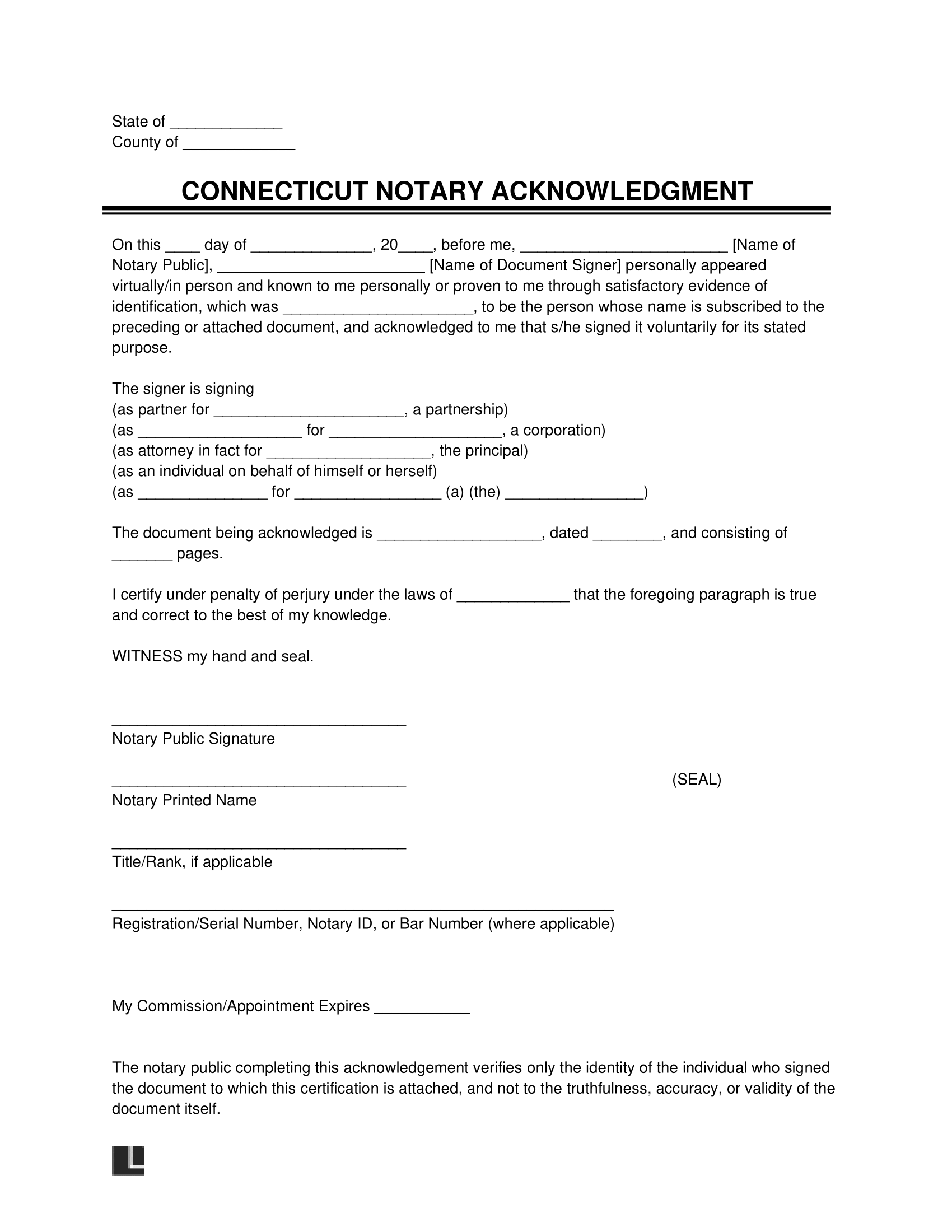A Connecticut notary acknowledgment form is a document used by a notary public to validate the execution of certain legal papers. To officially confirm and authenticate signatures, the notary public ensures that the signers are correctly identified and have signed willingly.
Unless the individual is familiar with the notarial officer, they are required to present either two or more current government-issued identification documents. Alternatively, they can opt for a credible witness to take an oath affirming their identity as a means of fulfilling the identification requirement. This process provides an added layer of assurance for the authenticity and validity of the signatures.
Legal Considerations
Statute: Connecticut General Statutes, Title 1, Chapter 6.
Form of Acknowledgment: According to § 6-1-34, it is tailored to different entities. For individuals, this includes specifying the state and county, the date of the event, the individual’s name, and a declaration of execution purposes. Corporations require identifying the representative and their authorization for instrument execution. The notary’s signature and official title are consistently included.
Notary Term of Commission: Five years (§ 33-3-94c(a)).
Notary Handbook: The Notary Public Manual serves as a resource to support officials in the effective execution of their responsibilities.
Is Online Notarization Legal in Connecticut?
Yes, effective October 1, 2023, Public Act No. 23-28 authorizes a notary public to conduct remote notarization, allowing them to notarize a document for an individual not physically present under specified conditions. It allows communication technology for real-time interaction between the notary and a remotely located individual.
Identity proofing involves verifying the remote individual’s identity through a third person using personal information from public or private data sources. The individual and the notary must communicate in real-time, and the notary must reasonably identify the individual through personal knowledge or various methods, including government-issued identification, identity proofing processes, or an oath by a credible witness.
Remote notarization is permissible for individuals outside the state if the document is related to state jurisdiction. Certain acts, including wills, health care instructions, and real estate closings, are excluded from remote notarization.
How to Notarize
Step 1 – Find a Notary
When seeking the services of a notary public, the initial step is to identify convenient locations where these professionals can be found. One option is to visit a local Bank or Credit Union, with People’s United Bank being recognized as the largest in the state. These financial institutions often offer notary services as a part of their customer support.
Another accessible choice is the UPS Store, where notary services are commonly available to the public. Additionally, you can explore the option of engaging a private notary service.
Connecticut General Statutes Sec. 3-95 provides that the charge for any service conducted by a notary public in compliance with the general statutes should not surpass five dollars, with an extra thirty-five cents for every mile traveled.
Step 2 – Bring Your Paperwork
Submit the fully filled-out document, excluding the signature fields, to the notary public for processing. Signatures should only be added to a document if you simply seek an acknowledgment. This step ensures that the notary’s role is focused on validating the identity of the signatories and confirming their voluntary signing.
Step 3 – Verify Identification
The notary will confirm the identities of all individuals signing the document by either examining a valid photo identification or through personal recognition. This essential step adds an extra layer of security and authenticity to the notarial act.
Step 4 – Sign the Form
You will sign the document in the direct presence of the notary. In situations where the document needs an acknowledgment and the signature fields have been pre-filled, each individual signing must explicitly declare, in the presence of the notary, that their signature was affixed voluntarily and without any form of coercion.
Step 5 – Complete the Certificate
After confirming the identities of the parties involved and witnessing the signatures, the notary proceeds to finalize the notarial certificate. Notably, in the state, using an official seal is not mandatory for a document to be recognized as notarized.
How to Verify a Notary
- Access the eLicense web portal to initiate the notary public search.
- Navigate to the “License Type” field, scroll through the options, and choose Notary Public.
- Use the search fields to input the notary’s name, then click “Submit.” A list of corresponding results will appear.
- For additional information about a specific notary, click on the “detail” button located next to their name.
How to Write (for Notary)
- Download a notary acknowledgment form in PDF or Word.
- Add the county and town/city where the document is being acknowledged at the top of the form.
- Enter the date, notary’s name, and the names of the signing individual(s) in the designated spaces. Two blank fields are provided for the notary to choose the suitable verb and proper noun.
- The notary is required to sign the form, input the date of their commission expiration, print their name, and affix their official seal or stamp.


